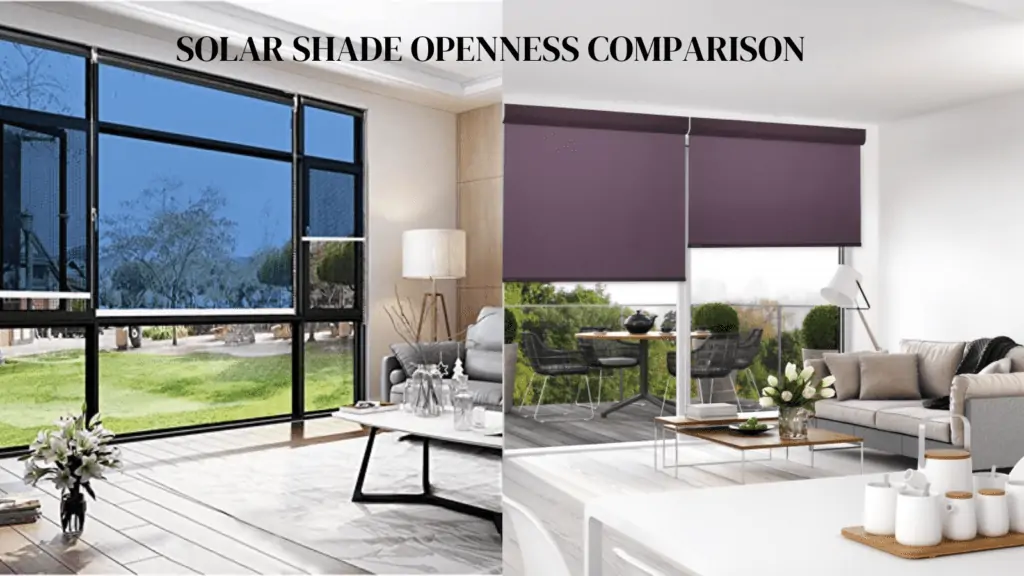This solar shade openness comparison allows you to decide how much sunlight you want to enter your home via solar shades. During the day, the sun’s rays can create natural light for your home if you have enough windows built into the structure.
The amount of sunlight entering your space will depend on the shade you use. Some shades allow more or less sunlight depending on their openness which you will learn more about today.
Let us look at the solar shade openness comparison to determine what best suits your needs.

Contents
- 1 What Is Solar Shade Openness?
- 2 What Do The Percentages Mean In Solar Shades?
- 3 What Are Solar Shades?
- 4 What Is The Best Openness For Solar Shades?
- 5 What Does 5 Openness Mean In Solar Shades?
- 6 Solar Shade Openness Comparison-Does It Matter?
- 7 Solar Shade Openness Comparison-Pricing
- 8 Solar Shade Openness Comparison-Best Solar Shades For Blocking Heat
- 9 Solar Shade Openness Comparison-View Ability
- 10 Do Solar Shades Give Privacy At Night?
- 11 Solar Shade Openness Comparison-Conclusion
What Is Solar Shade Openness?
Solar shade openness is a term used to describe the thickness of the material used to make solar shades. These shades use grade percentages to help identify how much sunlight will enter through them.
What Do The Percentages Mean In Solar Shades?
The higher the percentage, the more light enters the room; the opposite is true as well; lower percentages mean less light.
The most popular solar shade percentage is 5%. This fact finds its basis in collecting data on sales throughout the solar shade market.
Solar shades do not depend on solar to work, but the term relates to the solar-producing sun’s ability to penetrate their fabric.
What Are Solar Shades?
Solar shades are a window treatment that provides shade to a dwelling. These shades, also called screens, come in different sizes to fit any window space.
You can buy them in colors and material types. Depending on your needs, you can purchase a lighter or darker fabric to limit the amount of sunlight that enters your house.
Solar shades protect against too many ultraviolet rays entering your home, which can cause issues for you later on. Sunlight is good for you, but too much of anything could hurt.
What Is The Best Openness For Solar Shades?
The best openness for solar shades depends on a few factors, what the consumer prefers and what the experts think.
Whatever the consumer prefers will make that the best openness for them, but experts suggest that 7-10% openness is best to get the best of both worlds.
This percentage range allows enough of the sun’s rays to enter a room while still allowing persons to have some view of the outdoors. The higher the percentage, the more visibility you have; the lower percentages, the less you will see.
What Does 5 Openness Mean In Solar Shades?
Five openness in solar shades means the product allows 5% of the sunlight to enter the room through the screen’s texture.
This openness percentage is the most commonly used grade in households, which should help determine the solar shade openness comparison.
Solar Shade Openness Comparison-Does It Matter?
Does it matter to discuss solar shade openness comparison? We think so, as it helps buyers understand the differences in their choices.
Knowing more about the various grades and what they do will help when you are ready to buy. You won’t experience placing shades on your windows to realize they leave the room too dark or bright.
Not everyone will desire the same thing for their home, so knowing more about solar shade openness is a big plus.
Solar Shade Openness Comparison-Pricing
Solar shade prices will vary by size, texture, and brand name. A comparison on Amazon. one of the world’s leading retailers, ranges from $20 to $400.
You will find many companies that sell their brand of solar screens. These prices will vary in price range significantly.
Solar Shade Openness Comparison-Best Solar Shades For Blocking Heat
Solar shades will reduce the amount of sun exposure your inside receives, which could lessen the amount of heat entering your home.
The best solar shade designs for lessening the amount of heat entering your home are honeycomb and cellular shades. Another great protector from the heat is Silver Screen, a screen made by Insolroll.
One thing worth noting is that the materials used to build your home will help eliminate the heat felt inside; solar shades can only do so much.
Solar Shade Openness Comparison-View Ability
Some frequently asked questions about solar shade openness relate to what percentage will still allow visibility outside. Two of the more popular questions are:
Can You See Through 1% Solar Shades?
The answer to this question depends on the direction of the question. A person who has a 1% solar shade openness will find it difficult to see outside from inside due to the thickness of the screen.
During the night, a person outside can see through a 1% solar shade if the light inside the room is on. However, they will see shapes and not who is in the room, as 1% is very tight.
The critical factor in visibility is the light, making it easier to see through the shade. You will only see some shapes when you look out during the day; visibility will be inferior.
Can You See Through 3% Solar Shades?
The answer to the question of using a 3% solar shade is the same as a 1%, except that visibility will be slightly better. Since 1% means you prevent 99% of sunlight from entering your home, 3% would mean 97% doesn’t.
You will see the outdoors slightly better during the day while someone can see inside your room marginally better, but it will have limits.
Do Solar Shades Give Privacy At Night?
Solar shades will provide some privacy at night, depending on your usage percentage. This answer relates to having a light on in the room.
However, the privacy won’t be perfect as that light allows persons to see through the shade, even at 1%. 1% is the lowest you can go with shade openness; at this grade, you will see shapes in the room, but not who is there.
The higher the percentage of openness, the more visible the inside is with light. Once there is no light in the room, no one can see into your home.
Solar Shade Openness Comparison-Conclusion
Our solar shade openness comparison clearly showed the differences and benefits and gave definitions that will help you understand their purposes.
It depends on your needs if you want to know which solar shades are best for you. We hope this solar shade openness comparison was helpful!

